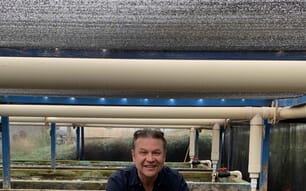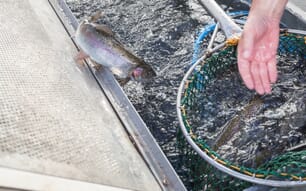Habitat and biology
Crucian carp are sedentary fish, which can propagate naturally in various types of water bodies, such as rivers and lakes. Crucian carp is basically an omnivore that naturally feeds on organic detritus, filamentous algae, small benthic animals, and pieces and seeds of aquatic weeds.
However, the fry/larvae feed on zooplankton. In addition, in aquaculture, they well accept artificial feed, such as by-products from grain processing and oil extraction, and pelleted feed. Rainfall, water level and temperature changes are the stimuli for reproduction. The presence of aquatic weeds is also important for spawning; they serve as the substrata for the eggs, which are adhesive. Crucian carp is a medium-size fish with a moderate growth rate that can reach 1.25 kg.
The major system used for rearing crucian carp is earthen pond culture, but rice paddies are also used in some areas of China.
Production cycle

Pond preparation
Earthen ponds are used for both spawning and nursing of crucian carp. The pond size is usually 0.07-0.2 ha and 1.5-2.0 m deep. Ponds are chemically cleared to eliminate all harmful organisms after totally drying; quicklime is the most commonly used chemical for eradication, usually applied at 900-1125 kg/ha. Organic fertilizer (animal and green manure) is commonly applied 5-10 days before stocking, depending on the water temperature, to increase the biomass of natural food organisms (zooplankton). The quantity of organic fertilizer used is usually 3000 kg/ha for animal manure or 4500 kg/ha for green manure. Green manure and animal manure may be used simultaneously, but the quantity of each is reduced accordingly.
Seed supply
Artificial propagation forms the major supply of seed for the culture of crucian carp nowadays, although natural seed is available in various types of water bodies. At present, the most commonly cultured crucian carp is Carassius carassius gibelio, which is produced through gynogenesis with female Carassius carassius gibelio and male Xingguo red common carp. Such heterogenous gynogenesis provides all-female offspring, whose growth rate is 30-40 percent higher than the original fish. Other species and strains of crucian carp are also cultured in various areas of China.
Hatchery production
Well-selected mature broodstock are released into spawning tanks/ponds/cages. Hormone injection is optional, since the fish can spawn well without it. However, hormone injection enables the fish to spawn more synchronously. The most important technique is to provide substrata of grass bundles, palm leaves, fine tree branches and plastic weeds in the water column of spawning facilities in which egg attachment can take place. Eggs can be hatched in earthen ponds where harmful organisms have been eliminated in advance. The eggs are simply moved into the spawning pond together with the substrata and fixed in the water column.
For better hatching, eggs can also be hatched in running water (raceway or jar). The substrata with eggs attached can simply be hung in the water column. The eggs can also be removed from the substrata for hatching in raceways or jars. Egg adhesivity is removed by mixing with clay solution prior to stocking. The hatchlings (fry) are transferred to nursery ponds when they are able to swim well and feed actively.
Nursery
Monoculture is the normal method for the nursery stage. The stocking density is usually 1.5-2.25 million/ha; the exact level depends on the length of the rearing period (2-3 weeks, which in turn mainly depends on water temperature) and the size required. Organic fertilization is carried out, ranging from 1500-3000 kg/ha every 4-5 days for animal manure or green manure, depending on water fertility. Soybean milk may also be used as both direct feed and fertilizer, to replace organic fertilizers in the nursery operation; the usual application level is 3-5 kg (dry soybean)/100 000 fish daily. The use of soybean normally increases production costs, but it is an easy method to handle. The application of a paste-form of soybean cake or other by-products from grain processing is required from the 5th day after stocking, usually applied at 1.5-2.5 kg/100 000 fish daily. Normal survival rates in nursery ponds are 70-80 percent, although they may reach over 90 percent under good management.
The fish usually reach the size of about 30 mm after 2-3 weeks. These are called summer-fingerlings in China and are then ready for fingerling rearing. Conditioning through careful netting and holding the fish at high density for a while (several hours) is required before transferring the summer-fingerlings to fingerling ponds; this practice increases the tolerance of the fish to transport stress.
Rearing fingerlings
Summer-fingerlings are not suitable for direct stocking in grow-out ponds. They need to be reared to a larger size (6-7 cm or larger) first. Fingerling rearing can be carried out in two different ways:
- To produce fish that can reach marketable size within the first year, summer fingerlings are stocked in fingerling ponds at 90 000-120 000/ha. After one month, the fish will reach about 6 cm and can be transferred to grow-out ponds for marketing within one year (one-year cycle fish).
- It is also common practice to rear crucian carp in fingerling ponds until the end of the year, in which case they are stocked at 150 000-300 000/ha. The fish can reach 10 cm (25 g) or even more by the end of fingerling rearing. Survival rate is 80-90 percent. At first, the fish mainly feed on natural foods enhanced by fertilizers or soybean milk. Later, additional commercial feeds (paste-form of soybean cake, rapeseed cake, wheat bran, etc.) are needed for optimal growth. These fingerlings are used to stock grow-out ponds in the following year, resulting in two-year cycle fish that achieve much larger market size and value than one-year cycle fish.
Ongrowing techniques
The most commonly adopted ongrowing techniques are polyculture in ponds/pens and rice paddies. Crucian carp is a bottom fish with relatively slow growth and production may often be relatively limited.
Polyculture in ponds/pens (semi-intensive to intensive)
In this system, crucian carp may be stocked either as the major species or as a secondary species, together with other carps. When crucian carp are the major species, the stocking rate is 22 500-30 000/ha of 25-50 g fish. Silver and bighead carp are also stocked as secondary species. After one year, the fish usually reach 150-400 g and production can reach 4000-6000 kg/ha.The production of secondary fish can also reach 3000-4500 kg/ha, giving a total productivity of 6000-10 000 kg/ha.
When crucian carp is the major species, the fish are mainly fed with commercial feeds. Crucian carp are omnivores that feed on both natural food and commercial feeds. Pelleted feed is becoming more popular when crucian carp is the major species in grow-out. Feed ingredients of pelleted feeds mainly consist of by-products from oil extraction (such as soybean cake) as the major protein source, and grain processing. The addition of animal protein (fish meal) is very limited (<10 percent), so the feed is relatively cheap. FCR as ~2:1. Fertilization can reduce the quantity of feed needed by enhancing natural food availability.
Crucian carp can also be stocked as a secondary species; in this case the stocking density is normally 1500-1800 fish/ha of 7-10 cm fish. Finally, the fish can reach 300 g and crucian carp production can achieve 450-900 kg/ha, which usually accounts for 5-10 percent of total production. When cultured as a secondary species, no special feeding is required for the fish. Crucian carp can also be cultured as secondary species in pens in shallow lakes; stocking and production levels are similar to pond culture.
Extensive culture in rice paddies
Crucian carp is also suitable for culture in rice paddies; stocking rates are 750-1500/ha. The fish mainly feed on natural food. Production can reach 300-450 kg/ha. This form of culture is also beneficial to rice, as a means of pest control and tilling the soil.
Harvesting techniques
Crucian carp, being a bottom-dwelling fish, are difficult to harvest effectively without draining the pond. Harvesting takes place at the end of the culture period firstly by netting at a reduced water depth, followed by total harvesting after drainage. Selective harvesting is also practiced by some farmers for balanced marketing; in this case the normal method is to use a casting net.
Handling and processing
Farmed crucian carp is entirely sold live or fresh. Drying and salting is only used for crucian carp caught from natural water bodies (rivers and lakes) by some traditional inland fishers.
Production costs
This varies according to the culture practice used but is normally below USD 0.70/kg.
July 2009




